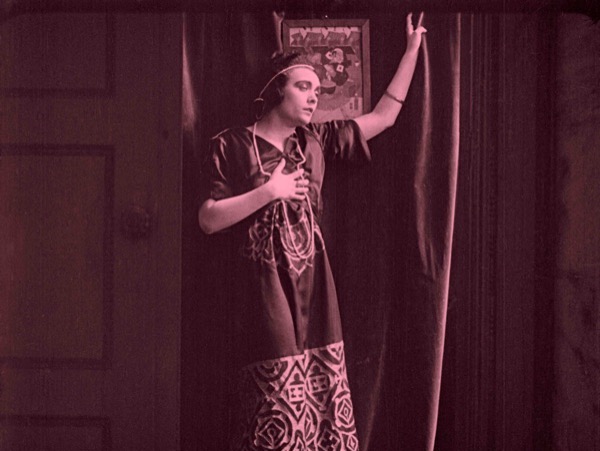MANIA. DIE GESCHICHTE EINER ZIGARETTENARBEITERIN
(Il calvario di un’anima) [Mania. The Story of a Cigarette Factory Worker]
Eugen [Jenö] Illés (DE 1918)
In 1918 the Warsaw cinema Stylowy placed an advertisement in the daily newspaper Przegląd Poranny (Morning Review), touting Pola Negri’s appearance in Mania and triumphantly proclaiming: “Played across 6 magnificent dramatic acts, with real events playing out in the background. The management draws your attention to the remarkably rich staging and costumes.” The film was well received in Poland, yet the star erased this and a few other titles from her official filmography. From the start of her Berlin period, Negri – talented actress, dancer, and brilliant manipulator of her own image – signalled that her career was crafted by Max Reinhardt, at the Deutsches Theater, and Ernst Lubitsch at Ufa. Thus, for some time she listed Die Augen der Mumie Ma (1918) as her first film.
In reality, Poland’s first native movie star – the “Polish Asta Nielsen”, as she was advertised back home – was invited to Berlin in 1917 not only by Reinhardt but also by Saturn-Film, the studio known at one time for risqué films. Before then, she’d been promoted by the Sfinks Studio and its head Aleksander Hertz, in films that consistently promoted her as the archetypal femme fatale, destroying the happiness of her lovers in films spanning from her debut, Niewolnica Zmysłów (Slave to Her Senses, also known as Love and Passion;1914) through to Bestia (1917; released in the U.S. in 1921 as The Polish Dancer), her sole surviving Polish feature. When she left Warsaw, she broke her contract with Hertz, and the subsequent legal dispute was widely covered in the press. According to Negri’s 1970 autobiography Memoirs of a Star, she won the case, though the reality is that the court found in favour of the producer, and ordered Pola to return to Poland and perform in the contracted films. Perhaps the whole legal process was just part of Hertz’s advertising strategy to guarantee a certain level of publicity; the attention cemented Negri as a much sought-after star.
“Black hair, dark eyes, smooth skin, mysterious voice” – this was the description of Pola in Berlin’s press. Saturn tried to bolster her image as the exotic femme fatale by giving her a baby tiger she was supposed to walk around with in the city. All told, she starred in 6 productions for them, yet the collaboration proved unsatisfying for both parties, and Negri moved to the Union studio, and Mania. The movie was directed by Eugen (Jenö) Illés (1877-1951) a well-educated Hungarian living in Germany from 1905. Though originally a journalist, he quickly found himself in the film business, first as director of Pathé’s Berlin offices and then, from 1912, as a film director and cameraman. The team behind Mania included Paul Leni, soon to become one of the most important figures in German Expressionism. His sophisticated art direction, enhanced by tinting effects, are among the film’s strongest assets, alongside the lively plot, absorbing performances, and interesting camerawork.
The main feature though is still Negri, endowed with original beauty, magnetic eyes, and an emotional range brought to life in vivid close-ups. There’s also her talent as dancer, first brought to the fore in Sfinks productions where her expressive, sensual dancing became her trademark. Don’t imagine her character’s surname in Mania, Walkowska, is an accident: whenever possible, Negri would sneak some Polish flavour into her Berlin productions.
German reviews of the film were strong, such as one in Der Film, which called Mania “a film drama which fully represents in every detail the unusual intuition and skills of its creators … Among all the actors Pola Negri gave the most outstanding performance, playing her role with strength and passion. It is interesting to see how the talent of this true artist grows with every performance.”
Mania was considered lost until 2006, when a nitrate print with extensive signs of ageing and decay was offered to the Filmoteka Narodowa by a Czech collector. The print is almost complete (1519 metres), and boasts rich tints: orange, olive, blue-green, and magenta, with emerald green for the intertitles. A 4K restoration was begun in 2010; in addition to cleaning up the image, the film’s division into 5 acts was re-established. Out-of-sequence shots as well as a number of missing intertitles were corrected and reconstructed based on German censorship cards.
Katarzyna Wajda

scen: Hans Brennert.
scg/des: Paul Leni.
cast: Pola Negri (Mania Walkowska, sigaraia/a cigarette factory worker), Arthur Schröder (Hans van den Hof, compositore/a composer), Ernst Wendt (Heinz Alex, pittore/a painter), [Werner?] Hollmann (Morelli, mecenate/a rich art patron), Ernst Hofmann.
prod: Paul Davidson, Projektions-AG “Union” (PAGU), Berlin, per/for Universum-Film AG (Ufa), Berlin [Union-Film der Ufa].
riprese/filmed: Ufa-Union-Atelier Berlin-Tempelhof.
v.c./censor date: 06.1918 (BZ.42041, 1682 m.), 12.10.1921 (B.04383, 1622 m.).
première: 08.11.1918 (Kammerlichtspiele, Berlin).
copia/copy: 35mm, 2393 m., 87′ (24 fps); did./titles: GER, subt. ENG.
fonte/source: Filmoteka Narodowa, Warszawa.
Ricostruzione digitale/Digital reconstruction: 2011.


 Italiano
Italiano